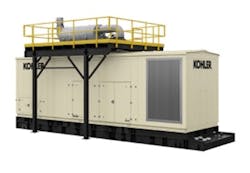New Technology and Practices Improve the Environmental Performance of Diesel Generators
In a new white paper, Kohler outlines the strides manufacturers are making when it comes to improving the environmental performance of diesel generators.
Get the full report
“The threat of climate change has resulted in urgent demand for more sustainable mission-critical power technologies,” according to a new white paper from Kohler. While the engine optimizations that resulted from the US EPA Tier 4 and European Stage V requirements have gone a long way to reducing harmful emissions, Kohler says generator manufacturers are taking other steps to further improve the environmental performance of their products.
Kohler cites new maintenance techniques as one area in which the generator industry has progressed. They note that mission-critical generators are “often used for less than 12 hours per year and at low loads since most of the runtime is for monthly exercising.” This presents a challenge because it leads to wet stacking, or a buildup of unburnt fuel in the exhaust system. Kohler outlines how technological advancements have created more efficient and environmentally friendly maintenance techniques that reduce emissions and improve engine performance.
“There is a genuine desire for more sustainable operations, from OEMs and end-users alike, and generator manufacturers have invested heavily in pursuit of more environmentally friendly technologies.” – Kohler, “Delivering More Sustainable Mission-Critical Generators – Now and in the Future“
Renewable fuels are another area in which generator manufacturers are investing heavily, according to the paper. The author explains how fuels like Hydrotreated Vegetable Oil (HVO) provide “a simple and efficient renewable alternative to fossil diesel that can be used right now.”
Finally, Kohler outlines how they and other generator manufactures are “evaluating the potential of revolutionary technologies for mission-critical power, such as batteries and fuel cells.” The paper explores the benefits, challenges, and practicality of each.
Download the full report to learn more about how engine optimization, new maintenance techniques, renewable fuels, and new technologies are improving the environmental performance of diesel generators.

Kathy Hitchens
Kathy Hitchens has been writing professionally for more than 30 years. She focuses on the renewable energy, electric vehicle, utility, data center, and financial services sectors. Kathy has a BFA from the University of Arizona and a MBA from the University of Denver.





